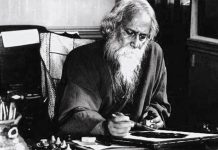SPECIAL ESSAY
In an intricate narrative, Rabindranath Tagore elaborates the world of a woman entangled in a man’s world and charts out her journey from unfreedom to freedom.
Ananya Pathak is a Feature Editor at The New Leam.

Rabindranath Tagore’s literary genius lay in his ability to carve out characters so grounded in the lived /mundane reality of the world that when they reflect any extraordinary brilliance or quality, the reader is encouraged towards a personal journey of self-discovery, because nothing looks impossible any more. Tagore’s own life trajectory brought before him a series of tragic encounters wherein he lost important members of his family to deathly diseases, he travelled the world and conversed with some the of the most brilliant minds of his time like Albert Einstein and Yeats. Although he was a mentor and friend to Gandhi (whom he handed over the legacy of Shantineketan) he had nuanced debates with him on the nature and symbols of the freedom struggle and on the uneasy terrain of nationalism and patriotic fervour among the youth. Tagore began writing at the age of just sixteen and throughout his life composed hundreds of songs and wrote poems, short stories, novels and plays. Regarded as a stalwart in literature and a thinker whose ideas were far advanced for his times , it would
not be surprising to consider him a radical feminist of the Bengal Renaissance in particular and of the Indian subcontinent in general.
Tagore’s literary creations and especially the depiction of female characters has contributed greatly to the discussion on issues considered a taboo whether it is widow remarriage, the bold participation of women in the outer world, the nonhierarchical friendship between individuals of different castes and religions, the dissociation of important characters with fatalistic nationhood and so on. Tagore’s texts had the calibre to raise complex emotional issues and important questions in the reader’s mind, a theme that runs across many of Tagore’s work is the urge to revisit social oppression and look beyond traditional obligations or parochial boundaries. What is interesting to note is that many of the questions and themes that Tagore raised through his work are in sync with the questions that feminism has generated. This is not to say that Tagore was a feminist in the modern sense of the term but what this does not take away from his credit is the fact that he aroused a sensibility, compelled his audience to engage with and deliberate on many issues that contemporary feminists also assert.
It is in this context that Streer Patra(The Wife’s Letter):an epistolary text written by Tagore becomes a significant case in point. The text is a brilliantly intricate commentary on the status of women in 19th century Bengal and the kind of nuanced arguments that the author makes through the portrayal of the characters, the myriad sentiments that flood their minds and the complex interpersonal exchanges that occur throughout the plot are an evergreen example of literary genius meeting feminist consciousness. Mrinal (an intelligent and particularly attractive rustic woman married into an upper-caste and upper-class Zamindari household in Bengal) is the protagonist of the story who narrates the mundane chores, the stringent regulations that women must abide by, and the non-spontaneity of women’s lives in feudal households and the existential quest of women to rediscover the self in spite of constraints. (“That I had beauty, it didn’t take you long to forget. But you were reminded,
every step of the way, that I also had intelligence.
This intelligence must have lain deep within me, for it lingered in spite of the many years I spent merely keeping house for you. My mother was always very troubled by my intelligence; for a woman it’s an affliction. If she whose life is guided by boundaries seeks a life guided by intelligence, she’ll run into so many walls that she’ll shatter her forehead and her future. But what could I do? The intellect that the other wives in the house lacked, the Lord in a careless moment had bestowed upon me; now whom could I return the excess to?) A turning point in the story comes when Bindu(a distant cousin sister of Mrinal’s sister-in-law who after being badly abused by her in-laws takes refuge in Mrinal’s home) is treated terribly and seen as a liability to be disposed of as soon as possible. Mrinal and Bindu develop a beautiful relationship but this friendship is cut short when Bindu is forcefully married to a mad man. Bindu runs away soon after her marriage and returns to Mrinal for help but her family compels her to return back to her husband despite Mrinal’s endless pleas.
Some days later Bindu commits suicide. Mrinal is jolted to the chore by this incident and her faith in the institution of marriage is completely lost, she decides to leave behind her own home and give up a conjugal bond which she feels is superficial and unholy. In the deeply profound and radically remarkable letter that she writes to her husband from the infinite seashore she describes the patriarchal oppression, the paradox of male intellect which rests itself on the backwardness of women and the birth of an independent consciousness which equips her to see the irony unravelled through her own life. She tells her husband that in spite of the many years of conjugal bond; he had never bothered to know that she wrote poetry or that she had a thinking of her own. Tagore threw light on the hollowness of the reform movement that was taking shape in 19th century Bengal and the coming in of the Bengal Renaissance.
While women were encouraged to get educated and widow remarriage was appreciated- it would take a great transformation in societal perceptions to impact the lives of ordinary women. Western-educated Indian men asserted that it was important to reform Indian society and culture in order to refute the British who had labelled indigenous cultures, knowledge and education ‘brutish‘ and ‘barbaric‘, The Indian men educated in western ideas felt compelled to empower women with education and cultural sophistication but what was ironic is the fact that even when reforms for the status of women were taking place no significant reform was taking shape in terms of generating women’s own agency and discretion in their own development. Women were being adapted or were adapting themselves to the standards decided by men without a say in their own destinies. Tagore’s female protagonists like Mrinal or Bimala from Ghare-Baire symbolised a void in the woman’s world generated out the denial of inner potential in a patriarchal world.
Tagore’s women were not submissive, helpless and marginalised creatures who would have no voice of revolt – his deeply spiritual and philosophic orientation gave his female protagonists an empowered awakening accompanied with the ethic of care. It is not surprising that ‘Streer Patra’ continues to be a perennial feminist text. Tagore radically used the subterfuge of the epistolary form to depict the dreams, agonies and aspirations of women under a patriarchal milieu that denied them dignity and intellectual space. As we commemorate his 157th birth anniversary his radical ideas continue to ignite the flame of feminist consciousness in our hearts and souls.














